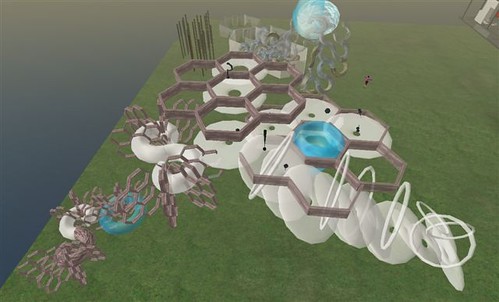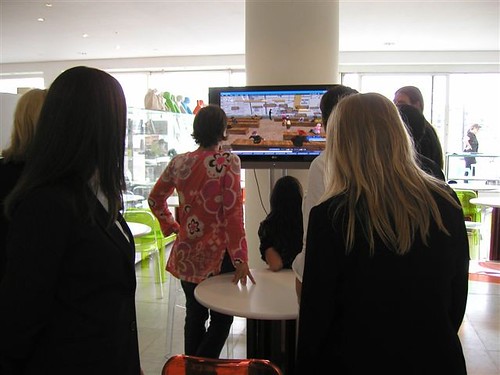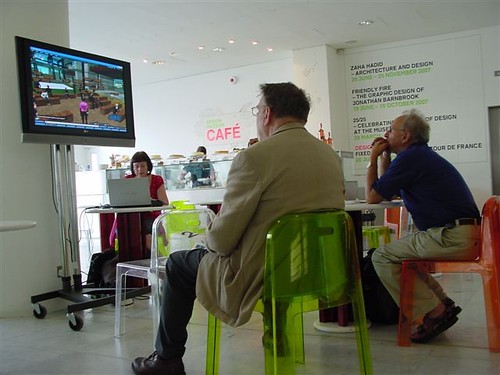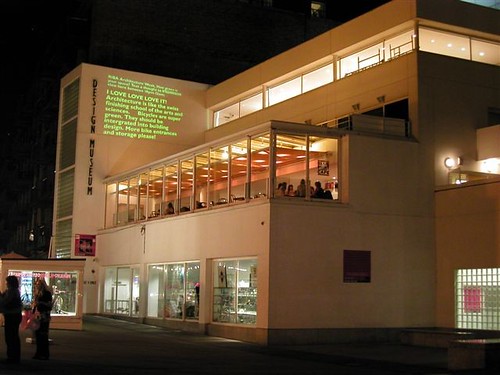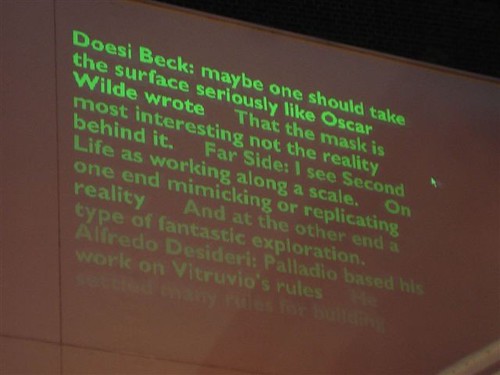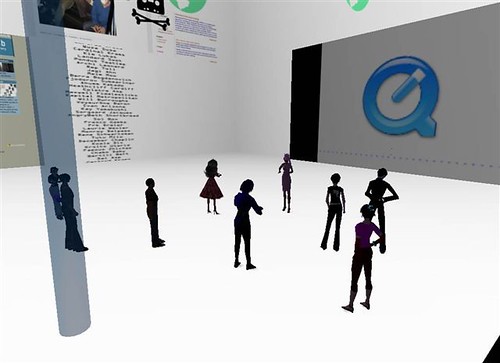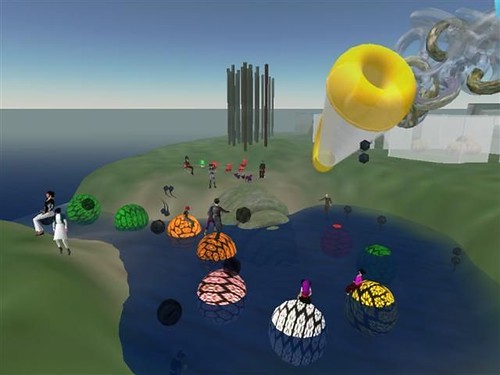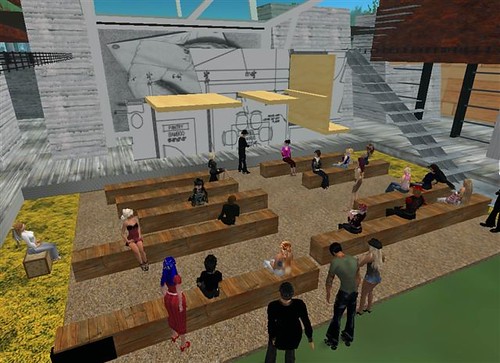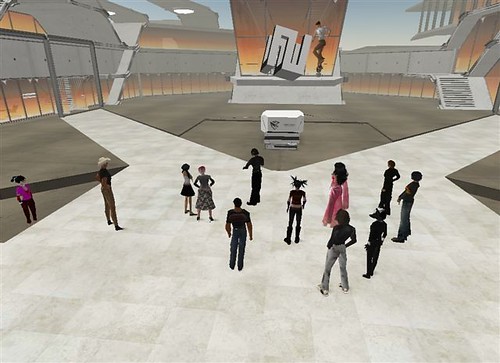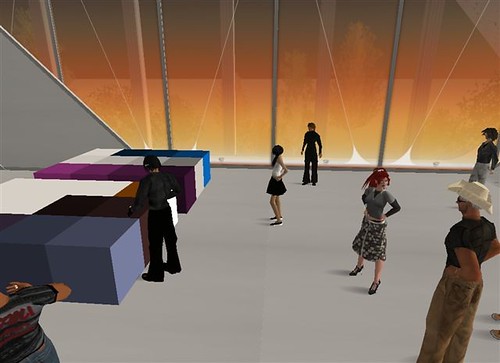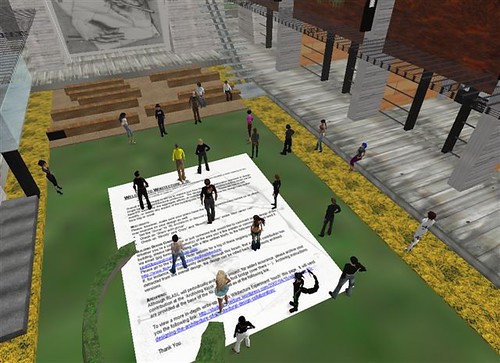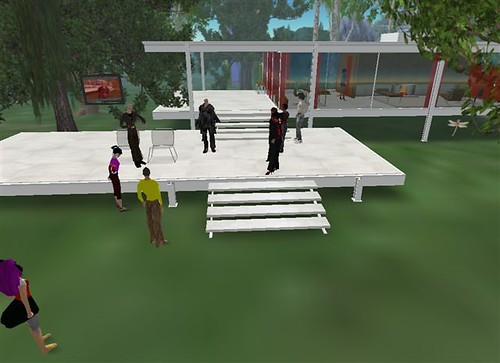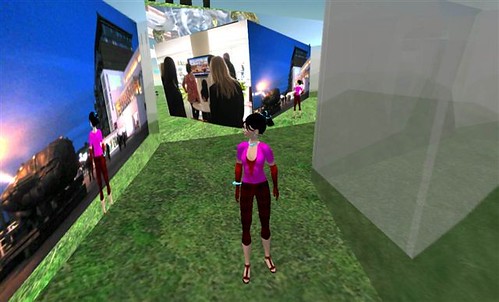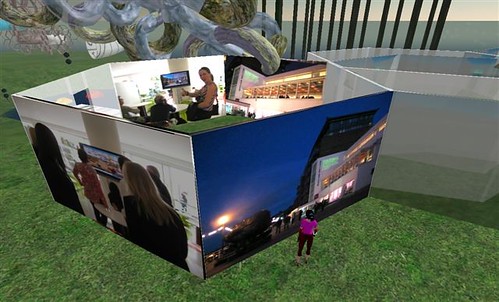The following essay was submitted by Fraser Fonda / Kate Allen. Slideshow of all Figures (by Fraser) posted HERE.
Introduction
The idea to hold meetings in Second Life developed in discussion with research group Performance in Transit, including mathematician Marcus du Sautoy, composer Dorothy Ker, chorographer Carol Brown and myself. We had had several meetings funded by the Gulbenkian Foundation and the AHRC, all at different locations in the UK. When the site of the next meeting was being discussed a virtual meeting in Second Life was suggested. This was conceived both in relation to practical considerations, that is, the problems of organising meetings between geographically dispersed participants; and as a way of exploring the various ideas and performances of multidimensional and virtual space. Key influences were the writings of Jorge Luis Borges1 and Marcus du Sautoy’s descriptions of the shape of the universe.
I created my Second Life avatar (the name of a digital character) Fraser Fonda in November 2006 and started to learn to use the building tools. I slowly began to understand the potential of Second Life and become aware of the possible links between Borges’ writing and the Second Life environment. In Second Life I was able to create impossible spaces with no
gravity, buildings as narrative, spaces of repetition, interaction, objects that could really only exist in the 4th dimension such as (The Klein Bottle)2, places to try to understand or work out concepts, objects direct from the imagination, all done with a click of a mouse. The project allowed for the narrowing of the barrier between the imagination and production creating a space that was reflexive and adaptive in real time, ubiquitous and ephemeral.
While learning to build in a Sandbox (a place where avatars can build without owning land) it felt a bit like having an open studio everyday – avatars would come by ask questions make suggestions and comment on my building. With a click of my mouse I could delete my object or store it in my avatar’s inventory to bring back at another time. Avatars could inhabit my buildings and interact with the objects I was making, immediately share their experience of it and their ideas. I found this experience different to creating models using 3D modelling packages, where the models I made were less easy to experience immersively, because of practical issues such as the complexity of 3D software, learning curves, hardware requirements, and file compatibility. It was difficult to give the viewer the sense that they inhabited the 3D modelled virtual space even using VRML, headsets, and CAVE technology. The Second Life experience is easy to use, and open to an international audience as it can be downloaded for free and works on most computers with a good graphics card. The viewer joins Second Life by creating an avatar, putting my audience in the digital space, giving the whole experience of viewing a more 3D experience. In Second Life my building can be explored more intuitively than viewing a predetermined fly-through animation. I found making work in Second Life nearer to creating real life sculpture in the studio than with a 3D modelling package, with the added advantage that in Second Life I could defy gravity if I wished, mix text, sound and video, script interactivity with much greater ease and playfulness than I had previously managed mixing media in earlier installations. In some ways Second Life gave me the control that a writer has when creating work mixing fiction and reality, immersing the reader in the author’s imagination.
I began to rent some land on Architecture Island. The island, owned by architect Keystone Bouchard is specifically for architects or projects concerned with architecture, and to encourage the architectural community to explore and share ideas in Second Life.
[Fig 1]
I started to build objects [Fig 1] in response to ideas discussed by members of the research group relating to Borges’ short story the Library of Babel which imagines the universe as a library, composed of an infinite number of hexagonal galleries, containing an infinite number of books. As avatar Taliesin Balhaus noted, architecture has always existed in a cloud of fantasy, historically the cloud has been mostly literary. There seemed many crossovers between Borges’ descriptions of the library and the digital environment, mixing up and confusing what is real and what is fiction. As avatar Designer Dingson put it “Second life has introduced a whole new level of conversation, where you constantly have to clarify ‘which world’ you are referring to – so as to stop any confusion!”
I attended talks and events held in Second Life and met people from all over the world who I would never have met or had conversation with in my real world life. The environment I was building became the catalyst for comment and discussion. For me Second Life became a meeting place, research space, and a place for the visualisation of ideas. For instance, Keystone set up the Real Life Architects in Second Life group and organised talks and events on a regular basis in Second Life. In his blog The Arch http://archsl.wordpress.com/ he documented how he had been using Second Life as part of his real life ecological architectural practice, discussed the architecture of Second Life and its potential use for real
life architects.
I proposed the research groups meeting place in Second Life as a project for RIBA Architecture Week 2007 as the theme was “How green is your space?” exploring ecological buildings. I thought it would be interesting to discover if Second Life could be considered as a green space for meetings and I proposed a meeting occurring in Second Life, with a live webcast in the real world. The Design Museum saw the potential of having a simultaneous virtual and real life meeting and offered to host the events in their café [Fig 2a]. The café provided an interesting transitory space; echoing the fluid nature of SL space, as avatar Doesi Beck put it: “the essence of architecture is the space between people and its construction, and Second Life shrinks, alters and extends this space.” Those watching on screen at the Design Museum experienced the live Second Life event through my avatar’s camera views and could ask me questions throughout the duration of the project [Fig 2b].
[Fig 2 b]
I found communicating with people in both worlds at once a challenge, as conversation in Second Life is by typing, which I do slowly and spell badly. (Recently voice has been added to SL, which would have made for a very different experience if it were available during the Architecture Week event).
I programmed a series of eight events for Architecture Week focusing on meeting in Second Life for discussions about architecture and design in Second Life and its relation to real life, and transcripts were posted on the Design Museum webpage after each talk. The transcripts can be read at http://www.auraproject.net/aura/index.php?title=Second_Life_%40_the_Design_Museum_London. The speakers who all gave their time for free were: Doesi Beck (Germany), Alfredo Desideri (Italy), Keystone Bouchard (USA), Kapitol Metropolitan (Sweden), Designer Dingson (UK), Chip Poutine (Canada) and Scope Cleaver (USA). Some of the texts from the Second Life discussions were projected onto the outside wall of the Design Museum in London at night creating another dimension to the meetings and the discussion [Fig 3b]. The projected texts were sent via mobile phone messages – the text number was also advertised to the public for one night to text their responses to the Architecture Week theme “How green is your space?” [Fig 3a]
[Fig 3 a]
[Fig 3 b]
Notes summarising the discussions from the Second Life @ the Design Museum talks
for Architecture Week 07.
During the first discussion by Doesi Beck I mentioned that some of the real life audience had commented that they were in the wrong place when watching the event happening on the screen in the Design Museum. This led Doesi Beck to question, “Which was the right place? The notion of the genius loci becomes one of the main questions of using media spaces.” The screen at the Design Museum showing the activity in Second Life highlighted the sense of disorientation when using an avatar, where you can ‘be’ in several places at once, sitting in front of your computer and at a discussion in Second Life, answering a question from an audience member at the Design Museum, while in conversation by Instant Message with someone in SL. Sometimes one can become distanced from the real world or confused about the context of a conversation or place. Where are you when the physical and virtual cross?
Avatar Far Link described it as a “question of inhabitation verses occupation”, occupation being the physical displacement of the body versus mental inhabitation. Doesi Beck clarified this by using the terms attached and detached to replace inside and outside to overcome the gap between mental space and physical space. He went on to talk about the idea of place in mediated worlds in his essay ‘Bastard Spaces’.
[Fig 4]
The boundary where real and virtual cross was also highlighted in the event organised by Kapitol Metropolitan, who streamed live video from WiFi cafés in Stockholm into his while some managed to see the live video but I could not get the QuickTime movie to work [Fig 4], probably due to the firewall or wireless connection at the Design Museum. I could only read the avatars’ text responding to the people on the video link they could see. I don’t think this detracted from the event; we discussed how I was imagining the scene from the response of the other avatars. One avatar commenting on the attractiveness of the Swedish architects she could see on the video link, was a bit embarrassed and very amused when it was explained that they could see what her avatar was saying and that the video she was watching was happening live. SL led to a confusion of realities that reminded me of Borges stories.
Communicating in Second Life by typing text affects the style of conversation between people; part of this is due to the time delay between typing, and reading what’s been said. The delay can lead to conversation disjunction, crossovers and sometimes interesting misunderstandings. Furniture and buildings are often scripted to speak, for example a chair will ask you to right click it to sit down. You also get a message when an avatar goes off line. All this text is interwoven into any conversation, which can become quite fragmented and sometimes absurd. All conversation is stored in a chat history and can be referred to and saved. Part of the development of my research group meeting was to use the build up of a textual landscape to create a library without boundaries. I asked the group to provide me with sentences from books they would like included in the SL version of a library. I scripted the texts into various objects and buildings, which when activated by the touch of an avatar would appear as quotes and so be integrated into the conversation and the environment on Architecture Island.
Composer Dorothy Ker asked me to install text into six floating spheres in an inlet the shape of a question mark (again inspired by Borges) so she could play them in a similar way to an instrument during the discussion [Fig 5]. The texts = created a space that was quite chaotic with the discussion being punctuated by the many different versions of texts often repeating, sometimes creating accidental sense. I built a version of The Klein Bottle, an object that can only be experience in the 4th dimension, a finite but unbounded space, as is the universe and is the revelation in the story of the ‘Library of Babel’ that the library is finite but unbounded. I hoped the objects built for the meeting would provide keys to start different conversations that the research group had discussed.
Keystone Bouchard gave two talks, one about using SL to visualise architecture and the other about the Wikitecture experiment where multiple contributors co-create a design. Keystone emphasised from the outset that building a community sharing and collaborating were some of the most important aspects of SL and that it was through community engagement with the various architectural groups in SL that had accelerated his learning curve. Keystone’s introduction into SL was through his ecological design residential architecture practice, which worked across a wide geographical area. He saw the possibility of using Second Life, because of its ubiquity and ease of use, to hold meetings with long distance clients. Also important was the ability to walk his clients through schematic design ideas which he found much more immersive and engaging than sending 2D pdf drawings by email. The building tools in Second Life may not be as extensive as some modelling programmes but are good for visualising the general concepts of an idea and can allow the client to test paint colours, furniture layouts and landscaping options etc.
Keystone gave a general overview of building techniques in SL and described how real life architects are using SL as a visualisation tool [Fig 6]. He explained how architects can build a design concept and test it out by inviting others to explore it and provide feedback, and he mentioned the aLoft hotel as an example. This was a full-scale replica of a hotel design soon to be built in real life in several destinations. The feedback provided by avatars in Second Life was used to revise parts of the design before it was built in real life. Keystone also saw further potential for architects where SL buildings could act as a virtual augmentation of a real building, for example a conference centre where virtual conferences are held to compliment real life conferences. Big companies such as IBM already use SL for meetings. Keystone then described the other opportunity for architects in SL to consider, building for the virtual environment. He felt that architects should lead the way as to how the two worlds interface and overlap. In response to a question from avatar Bjorlyn Loon whether the architectural community was beginning to catalogue some of the differences between real life and Second Life builds and find ways to address the differences, the general feeling was that although individual members are starting to discuss these issues (such as Chip Poutine’s Virtual Suburbia blog http://www.virtualsuburbia.com/) there needs to be a lot more discussion. Keystone said that a new language for virtual architecture was needed. Far Link agreed suggesting the need for a new ‘5points’ manifesto for virtual design.
Scope Cleaver is an avatar working with virtual architecture and design – he had just joined forces with designer Maximilian Milosz and gave a tour of their new store [Fig 7a] selling furniture and designing buildings in SL.
[Fig 7b]
Scope gave an interesting talk describing his creative process which was very painterly, starting with creating a colour palette [Fig7b]. Unlike Keystone’s descriptions of working from plans Scope described a more intuitive freestyle approach to building with lots of trial and error, but using a great deal of control over his textures and the composition of the build describing how he tries to make the building ‘photogenic’ from certain angles which also dictated where the vegetation would go.
Lecturer of art history Alfredo Desideri felt it was important that new architecture must be informed by architectural history and this influenced his building in SL. During his tour he described how Palladio had based his work on the teaching of Vitruvio and that he lived during a period of experimentation. Alfredo said that Le Corbusier had taken Palladio’s rules and modified them to create his work; Alfredo’s challenge was to modify these rules to make buildings that would fit with the mind avatar “as behind every avatar is a man or woman”. A memorable moment of Alfredo’s tour was his building scripted to turn us all in to classical statues. [Fig 8]
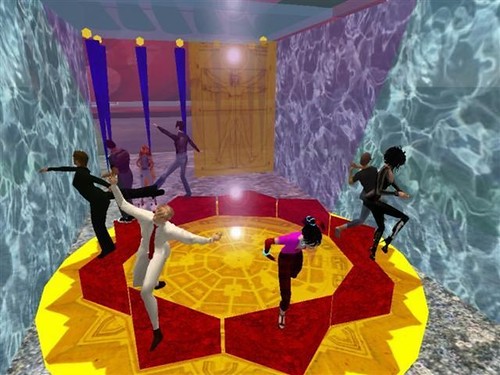
[Fig 8]
This provided a great communal moment – the building needed our participation to be complete and the intervention of his script on our avatars was funny and broke down any shyness we might have had as a group.
Conversation and collaboration led Theory Shaw and Keystone Bouchard to develop the idea of Wikitecture [Fig 9], which experimented with communal building in SL, providing a catalyst for an ongoing discussion about co creating and collaboration in virtual worlds. Second Life allows you to choose who can modify your objects and you can set a group to do this. The project is still in development, creating lots of discussion; Chip Poutine described it as a kind of architectural jazz. The first experiment highlighted several issues that needed to be worked out before the next wikibuild, such as a good method of automatically recording changes to the build and some kind of voting mechanism. Chip Poutine pointed out a fundamental problem with the wikibuild idea, using the example of the Wiki encyclopaedia where the discussion forms around sources and research to gain a consensus toward an objective fact, whereas in matters of architectural design the discussion is much more subjective.
[Fig 9]
This led to a discussion about value and leadership and would a collaborative build lead to the lowest common denominator? There was a sense in the discussion that the ease of changing and erasing buildings in SL would prevent this and in a way SL is a group of personal wikis constantly changing building conversations.
A topic that came up in several discussions was why much of the architecture in SL was built to replicate architecture in the real world and why is it often quite boring? How is form being generated when there are no functional or economic limits? Chip Poutine noted that the pastoral landscape of SL creates a certain kind of response; he also said we just drag in our baggage of what we think architecture should look like. Chip talked about the difference between making computer games where the space created in the computer was not only a representation of something to be built in the real world but rather an architectural artefact in and of itself. Second Life encompasses both ends of the spectrum: as Far Link put it “I see it working along a scale at one end mimicking reality and at the other a fantastic exploration.” Keystone felt that taking cues from real life is an important step in the transference between worlds. Design primes the viewer into a particular kind of mindset that informs the dialogue and interaction within the space.
Second Life can give you the opportunity to live a lifestyle that far exceeds your real life possibilities. SL can be used to build virtual copies of real life buildings and showcase clients projects. Designer Dingson bought a copy of the Farnsworth House [Fig 10] created by Maximilian Milosz to share his interest and admiration for Mies Van de Rohe with the rest of the world and to inspire us to visit the real building.
He describes how the building works well in the perfect world of SL where the sharp edge of modernism cannot be blunted by time and the elements. In his talk he wondered if owning the virtual house rather than having to live in the real version was more enjoyable as the real life upkeep, the leaves staining the decks, the threat of flooding, the bugs at night, the ventilation etc distracted from the beauty and simplicity of the house. Designer Dingson created a series of easels in the grounds of the Farnsworth House, which set out the history, and design of the house. The talk was given in collaboration with Chip Poutine who spoke from a personal perspective charting his interest in the idea of Virtual Architecture since the mid 1990s waiting until a virtual environment arrived that could allow his ideas to be fulfilled. Chip described his idea to create a memory space – a contemporary digital manifestation for a classic mnemonic device used by orators to deliver speeches over two hours long with out the use of notes. The project remained theoretical in the mid 1990s as a feasible technology platform for the project did not yet exist. Chip joined Second Life in 2005 realising that SL had the potential to be the kind of space he had been waiting for 10 years where he started writing about the architecture in Second Life and began his virtual architectural practice.
Doesi Beck argued that Second Life is not replicating reality but replacing it – it is a metaphor but also a reality. Simulation can become real – for example someone simulating an illness can make themselves really sick. You can be arrested for illegal activity roleplay. SL will change how the virtual world is rendered. Which brings the discussion back to RIBA theme “How green is my space?”. Keystone described SL as the ultimate in sustainable design, bringing people together from all over the world without the energy required to physically meet in one place. He also took into consideration the many servers and computers consuming energy, which had also been an argument in other discussions about SL green credentials, but he believes as virtual environments become increasingly viable and easy to use they will replace certain kinds of physical architecture [Fig 11a].
In conclusion Second Life can be teaching tool in how to inhabit virtual space. [Fig 11b]
[Fig 11a]
[Fig 11b]
The essentially ephemeral nature of building on Second Life creates a perfect laboratory environment for art and architecture to try out ideas for interactive multimedia, interactive scripted objects etc – for example the walls of an SL building could fluctuate in response to a share price going up in the real world. These experiments can be tried out easily and at a fraction of the real world cost. The visual nature of the discussion in SL helps to understand difficult concepts, as does the possibility for collaboration and sharing ideas and information.
Kate Allen 2007
1 Borges, Jorge (1985), Fictions, London: John Calder Publishers Ltd
2 http://www.kleinbottle.com/whats_a_klein_bottle.htm
3 http://www.designmuseum.org/media/item/71746/688/Stephan_Doesinger_competition.pdf
